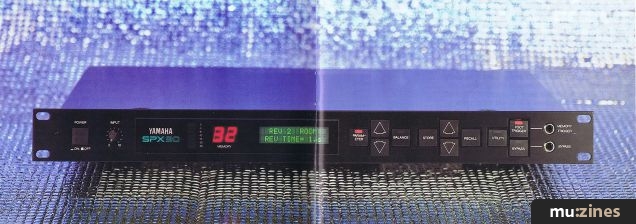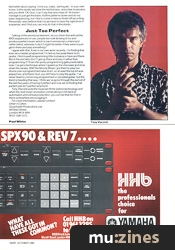Magazine Archive
Home -> Magazines -> Issues -> Articles in this issue -> View
Yamaha SPX90 Multi-Effect Processor | |
Article from Electronics & Music Maker, March 1986 | |
Yamaha's rack effects box to end all rack effects boxes. Tim Goodyer finds out why you might want two.

Just when you thought it was safe to leave your 19" rack in the corner, Yamaha introduce a revolutionary new rack-mount machine. The SPX90 is a digital stereo multi-effects processor, which, in layman's terms, means that Yamaha have stuffed almost all the currently fashionable digital effects into one box, in order to give the user maximum results from a minimum of gear.
We've seen a number all-singing, all-dancing effects units before now, but most have failed in a vain attempt to pander to the differing requirements of guitars and synths. Let's face it, if anything could be all things to all men, Quentin Crisp would have sussed it years ago.
Yamaha have made their FX choices carefully: there's no distortion and no sustain, so this is definitely a piece of gear for hi-tech rather than three-chord thrash applications.
Internally, the SPX90 is a digital reverb with a DDL thrown in, or is that a DDL with a reverb thrown in? I suspect the latter, but either way, this system partially overcomes one of the average DDL's greatest shortcomings: its inability to give reverberation that doesn't sound like Marvin the Paranoid Android. The '90 covers Hall, Room, Plate, and Vocal reverb times, but in truth, they represent only the start.
You can also obtain mono delays up to 500mS long, stereo echoes of up to 250mS, plus a load of gating, parametric EQ and sampling facilities thrown in. About the only real concession to the guitarist is the inclusion of a compressor, but I think I could live with that.
The unit comes with 30 preset programs on internal ROM, and will store a further 60 user programs in RAM, the program in use being indicated by the front panel LED display.
Basically, the factory programs cover a wide variety of eventualities from reverb, chorusing, flanging and auto-panning, to echo and pitch-changing. These presets then provide the starting point for your own programs, and each is made up of up to nine user-variable parameters. The present setting appears on the front panel LCD, and can be adjusted using the familiar increment/decrement method. The resulting program is then stored under one of the user memories with the help of the Store button.
Needless to say, the SPX90 offers the usual MIDI program-with-patch-change facilities for control from an external MIDI synth. MIDI also facilitates pitch control over the SPX90's Freeze programs, which a quick reference to my Yamaha/English phrasebook assures me are monophonic samples. The unit will hold a sample of up to 500mS in length, and depending on what mode you're in, this can be simply a retriggerable sample or a pitch-controllable (over five octaves) one. Editing of both start and end points is possible, and you can play your sample backwards simply by setting the start point nearer the end than the end point - easier done than said.
The SPX has a couple of foot-switchable features, useful for those with their hands already full of keys.
The first of these is a Bypass facility which simply defeats the current effect and allows your untreated signal to appear at the machine's outputs. The second is a little more involved, has a dual function and goes under the name of Memory Trigger. In its first mode of operation it allows footswitch selection of pre-determined programs in conjunction with the Utility button, and in its second, it triggers Gate and Freeze effects.
Finally, those who like to keep well away from their racks in the normal course of composing/performing/recording will be glad to know there's the option (at extra cost) of a hand-held remote control unit, the RC7.
The SPX90 had been in our hands less than a day when this issue of E&MM went to press, so I'm afraid I can't be any more specific about the effects it produces or how they sound. You'll just have to wait until a future issue for that.
Its specification makes mighty impressive reading, though, and my only major doubt concerns what you're supposed to do if you want to flange your echo effects, and then add just a modicum of reverb. Anyone for a bank of SPX90s?
Price RRP £599
More from Yamaha Kemble, (Contact Details)
Also featuring gear in this article
Fade away and radiate
(MX May 95)
Hands On: Yamaha SPX90
(SOS Dec 91)
Jack Of All Trades - Yamaha SPX90
(HSR May 86)
Mono Mode (Part 4)
(MT Nov 86)
The Power Behind the Button - Yamaha SPX90
(EMM May 86)
Trigger Converter for the Yamaha SPX-90
(HSR Jul 86)
Yamaha SPX90
(SOS Apr 86)
Yamaha SPX90
(MM Apr 86)
Yamaha SPX90
(12T May 86)
Yamaha SPX90 Effects Processor - Studio Test
(IM May 86)
Browse category: Studio/Rack FX > Yamaha
Publisher: Electronics & Music Maker - Music Maker Publications (UK), Future Publishing.
The current copyright owner/s of this content may differ from the originally published copyright notice.
More details on copyright ownership...
Review by Tim Goodyer
Help Support The Things You Love
mu:zines is the result of thousands of hours of effort, and will require many thousands more going forward to reach our goals of getting all this content online.
If you value this resource, you can support this project - it really helps!
Donations for April 2024
Issues donated this month: 0
New issues that have been donated or scanned for us this month.
Funds donated this month: £7.00
All donations and support are gratefully appreciated - thank you.
Magazines Needed - Can You Help?
Do you have any of these magazine issues?
If so, and you can donate, lend or scan them to help complete our archive, please get in touch via the Contribute page - thanks!















